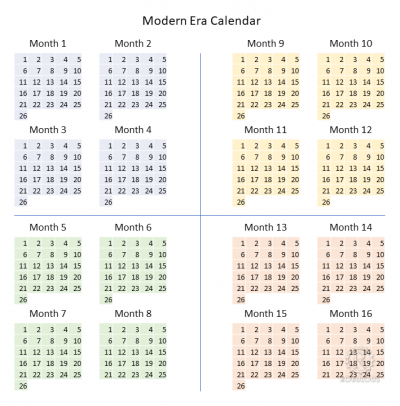Modern Epoch (ME)
The Modern Calendar is a dating system acknowledged throughout the Civilised World. It numbers years from the Modern Epoch, abbreviated ME and BMEplugin-autotooltip__small plugin-autotooltip_bigBME (Before Modern Epoch)
Used to date years Before the Modern Epoch. (Before Modern Epoch). It is also called the Modern Era.
This is in a series of articles about calendarsplugin-autotooltip__small plugin-autotooltip_bigCalendars
Many different calendars have been used during Helevos' long history. Most societies used individual calendars starting either with their founding, or from some religious or political event. This made comparative history a confusing subject, particularly with the passage of time. and dating systems.
The numbering of years is based on epochsplugin-autotooltip__small plugin-autotooltip_bigWorld History
Helevos has eight thousand years of recorded history, with archeology, artefacts and myth stretching back much further. There are two dominant views of human history: the theological view that the whole world and humanity were created some thousands of years ago in one instant of creation; the second, that all humanity descends from a race of fallen demigods called the viridEmerald EpochBMEgreenBMEAnásthiasAnásthiasBMEAnásthiasfolkloreMiyarrisGodmenBMEMEOrorrHartheraMEviridAnásthi… of the old Hirèrk Moonscale (HMplugin-autotooltip__small plugin-autotooltip_bigHirèrk Moonscale
The Hirèrk Moonscale [Hee-Rerrk] (HM) is a luni-solar calendar used at least since the time of Miyarris, which measures cycles based on the moons, solar years as well as the millennia-long cycles of global climate change. Today years HM are only seen in historic works and not considered accurate in historical accounts.epochHMHMBMEepochsepochsepochepochepochepochepochHMepochsMEME), devised by the ancient civilisation of Miyarris, though with significant reforms to months of the year.
History
Historically many different calendarsplugin-autotooltip__small plugin-autotooltip_bigCalendars
Many different calendars have been used during Helevos' long history. Most societies used individual calendars starting either with their founding, or from some religious or political event. This made comparative history a confusing subject, particularly with the passage of time. were used around the civilised world.
The Hirèrk Moonscale was developed in ancient Miyarris, and was used as an international calendar throughout the Beryl Epoch, particularly for diplomacy and academic writing. It followed the phases of the moon Themsa, with each month being 41 days, making just under 10 months in a year.
Today ME is the official calendar of the two great powers of Ororr and Harthera, since this epochplugin-autotooltip__small plugin-autotooltip_bigWorld History
Helevos has eight thousand years of recorded history, with archeology, artefacts and myth stretching back much further. There are two dominant views of human history: the theological view that the whole world and humanity were created some thousands of years ago in one instant of creation; the second, that all humanity descends from a race of fallen demigods called the viridEmerald EpochBMEgreenBMEAnásthiasAnásthiasBMEAnásthiasfolkloreMiyarrisGodmenBMEMEOrorrHartheraMEviridAnásthi… roughly coincides with important events in the founding of both nations. Therefore most nations either use ME, or are aware of the current date and year in relation to their own national calendar.
Annual calendar
The standard calendar has four seasons each of four months, 16 months making up a year of 414 days. Nations who follow the ME calendar have some variation in the naming of days and months within the year, and measure weeks in different ways.
Months have 26 days, with the exception of the months approaching the summer and winter equinox which have 25 days. The year is actually 414.2 days, so the calendar adds a leap year every 5 years, adding an extra day at the summer equinox month. This is a holiday in many nations.
- 1 day = 20 hours
- 1 year = 414 days plus a leap day every 5 years
- 1 month = 26 days, months of summer and winter equinox have 25
Many nations have a public holiday on the first day of each month, though many have specific religious holidays at various times in the year.
Month names
 Names of the months vary by languageplugin-autotooltip__small plugin-autotooltip_bigLanguages
Names of the months vary by languageplugin-autotooltip__small plugin-autotooltip_bigLanguages
List of human languages and dialects, contemporary and extinct.
Language
language
This is in a series of articles about Languages and Communication.
topics sidebar cult1, but are all derived from the Mayápo meaning first month, second month etc.
| Month | Days | Mayápo | Ororrplugin-autotooltip__small plugin-autotooltip_bigOrorr Ororr [o-ROARR, ɒ̝rɔ'ɾ], also called the Holy Motherland of Ororr, is a theocratic nation in Anásthias, one of the world's great powers. It the largest nation in the world, perhaps the largest empire in history, occupying the entire northwest of the continent between the mountains and the sea. Ororrlanguagelanguagelanguage | Hartheraplugin-autotooltip__small plugin-autotooltip_bigHarthera The Hartheran Union, commonly named Harthera, is an imperialist maritime nation state dominating the northeast of Anásthias. It is one of the two great powers of the modern epoch, arguably the most technologically and militarily powerful nation in the world, only matched by the vast size and wealth of its neighbour, viridOrorrMEOrorrOrorrOrorrOrorr |
|---|---|---|---|---|
| 1 | 26 | Ahkem | Ekhoum | Amec |
| 2 | 26 | Iyem | Eehoum | Eemec |
| 3 | 26 | Ishem | Issoum | Ishmec |
| 4 | 26 | Lahayem | Layoum | Hoymec |
| 5 | 26 | Lunem | Lanoum | Lumec |
| 6 | 26 | Zukem | Sekoum | Soumec |
| 7 | 26 | Zoonem | Senoum | Sanmec |
| 8 | 25 | Ooshiem | Seshoum | Ouvmec |
| 9 | 26 | Kukem | Keekoum | Cushmec |
| 10 | 26 | Ahtoukem | Etaykoum | Atumec |
| 11 | 26 | Oorounkem | Urukoum | Roumec |
| 12 | 26 | Iyeoorem | Yoroum | Yumec |
| 13 | 26 | Shushem | Sousoum | Metahmec |
| 14 | 26 | Laypiem | Laypioum | Elaymec |
| 15 | 26 | Luliem | Lulioumm | Loymec |
| 16 | 25 | Zuwiem | Soupioum | Anomec |
Weeks
National calendars most vary in terms of weeks. Ororr traditionally had an 8 day week cycle, while other nations use five or six-day weeks.
Harthera uses a six day week, inherited from the ancient Junda calendar, with 69 weeks in a solar year.
History
The upheavals caused by climate change and conflict during the Fifth Epoch HM led to the collapse of many former nationsplugin-autotooltip__small plugin-autotooltip_bigFormer nations
This is a list of former and historic nations, from ancient civilisations to recently extinct states.
Former nation subcategories
topics sidebar hist1 geog1, and the rise of the two great modern powers of Ororr and Harthera. Both nations originally used a confusion of independent calendars in their early years.
In the decades after between the collapse of the Empire of Dor-en-Sann and the foundation of Ororr there were several competing systems. The first (used in Old Ororr) dated from the founding of the Mother Army (29 ME), the second from the Prophet Therion's declaration of the new nation of Ororr (52 ME), and the third (in the east) from the fall of the city of Galkesh. The old Imperial heartlands continued to use the Imperial Calendar until it was officially banned, whilst academics continued to date events from the start of the Fourth Epoc HM. Importantly, the Great Prophet refused to express an opinion on the subject, considering it a matter for the burgeoning Ororran bureaucracy.
Early Harthera had similar problems. The Junda conquerors officially used the traditional Junda Stormscale. The system of marking years by storm tides was vital to coastal life, but useless for agriculture since one storm year is 1.3 years of the Saloyan solar calendar.
By the third century ME, leaders in both nations saw the urgent need for calendar reform, desiring a more accurate and universal system which would benefit both international trade and co-operation. Traders and academics had for some time been using the Hirerk Moonscale for recording dates and shipping schedules, being both accurate and culturally neutral, and so both nations eventually adopted a modified form of it.
Divergence from the Moonscale
According to Moonscale, the Fifth Epoch (the shortest) ended in 701 ME, making modern times the Sixth Epoch HM. Since neither Harthera nor Ororr had any particular desire to reset their calendars on this date, a mutual decision was made to continue numbering years as before. Thereafter, years were referred to as being in the “Modern Epoch” or “Modern Era”.

